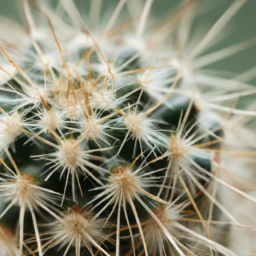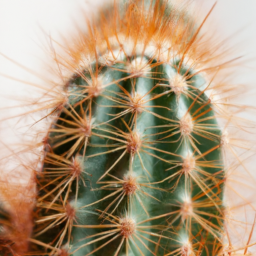
Are you looking to bring a touch of desert charm into your home? If so, you’re in the right place! In this blog post, we’ll be exploring the wonderful world of types of cactus indoor. Cacti are not only low-maintenance plants but also add a unique aesthetic to any indoor space. Whether you’re a seasoned plant parent or new to the world of indoor gardening, there’s a cactus out there for everyone. So, let’s dive in and discover the different types of cactus that can thrive inside your home.
Popular Types of Indoor Cactus Plants
Introduction
When it comes to adding a touch of greenery to your indoor space, cactus plants are a popular choice. Not only are they low-maintenance and easy to care for, but they also come in a wide variety of shapes, sizes, and colors. In this guide, we will explore some of the most popular types of indoor cactus plants that you can add to your home or office.
Small Indoor Cactus Plants
Small indoor cactus plants are perfect for adding a pop of color and texture to your space without taking up too much room. One popular option is the Bunny Ear Cactus, also known as Opuntia microdasys. This cactus features flat, oval-shaped pads that resemble bunny ears, hence its name. It is easy to care for and produces vibrant yellow flowers in the spring.
Another popular small indoor cactus is the Moon Cactus, also known as Gymnocalycium mihanovichii. This cactus is unique in that it does not have chlorophyll, so it cannot photosynthesize on its own. Instead, it relies on a grafting process with a different type of cactus to survive. The Moon Cactus comes in a variety of bright colors, making it a fun and colorful addition to any indoor space.
For those looking for a small indoor cactus with a more traditional look, the Golden Barrel Cactus, also known as Echinocactus grusonii, is a great option. This cactus features a round, barrel-shaped body covered in golden-yellow spines. It is slow-growing and can live for many years with proper care.
Tall Indoor Cactus Plants
If you have high ceilings or a large indoor space to fill, tall indoor cactus plants can make a bold statement. The Saguaro Cactus, also known as Carnegiea gigantea, is one of the largest cactus species and can grow up to 40 feet tall in its native habitat. While it may not reach those heights indoors, it can still grow to an impressive size with proper care.
Another tall indoor cactus option is the Organ Pipe Cactus, also known as Stenocereus thurberi. This cactus features multiple tall, columnar stems that resemble organ pipes, hence its name. It is native to the deserts of Arizona and Mexico and can grow up to 20 feet tall indoors.
For those looking for a tall indoor cactus with a more unique appearance, the Totem Pole Cactus, also known as Pachycereus schottii monstrosus, is a great choice. This cactus features a tall, columnar stem that is covered in irregular bumps and ridges, giving it a quirky and interesting look.
Flowering Indoor Cactus Plants
For those who love flowers, flowering indoor cactus plants are a great option. One popular choice is the Christmas Cactus, also known as Schlumbergera bridgesii. This cactus produces bright, colorful flowers in shades of pink, red, orange, and white around the holiday season, hence its name. It is easy to care for and can live for many years with proper care.
Another flowering indoor cactus option is the Easter Cactus, also known as Hatiora gaertneri. This cactus produces vibrant pink, red, or white flowers in the spring, making it a cheerful addition to any indoor space. It is easy to care for and can thrive in low light conditions.
If you prefer a more exotic look, the Orchid Cactus, also known as Epiphyllum hybrids, is a great choice. This cactus produces large, showy flowers in shades of pink, red, orange, and white that resemble orchids. It is easy to care for and can bloom multiple times throughout the year.
In conclusion, there are many different types of indoor cactus plants to choose from, each with its own unique characteristics and care requirements. Whether you prefer small, tall, or flowering cacti, there is sure to be a perfect option for your indoor space. Remember to provide your cactus plants with plenty of sunlight, well-draining soil, and occasional water to help them thrive and grow.

Best Indoor Cactus Varieties for Low Light Environments
Introduction
When it comes to choosing the best indoor cactus varieties for low light environments, there are a few key factors to consider. Cacti are known for their ability to thrive in sunny, arid conditions, but there are also some varieties that can do well in low light settings. In this guide, we will explore some of the best indoor cactus varieties that are well-suited for low light environments.
Factors to Consider
When selecting indoor cactus varieties for low light environments, it is important to consider a few key factors. First and foremost, it is essential to choose cacti that are known for their ability to thrive in low light conditions. Some cacti are more adaptable to low light than others, so it is important to do your research before making a selection.
Another factor to consider is the size of the cactus. Some cacti varieties can grow quite large, while others are more compact and better suited for indoor spaces. If you have limited space, it is best to choose a smaller variety that will not outgrow its container.
Lastly, consider the care requirements of the cactus variety you choose. Some cacti are more low-maintenance than others, so if you are new to caring for cacti, it is best to choose a variety that is easy to care for.
Best Indoor Cactus Varieties for Low Light Environments
1. **Zebra Cactus (Haworthia)** – The Zebra Cactus is a popular indoor cactus variety that is well-suited for low light environments. This cactus has striking white stripes on its leaves, giving it a unique appearance. The Zebra Cactus is also low maintenance and does not require a lot of sunlight to thrive.
2. **Moon Cactus (Gymnocalycium mihanovichii)** – The Moon Cactus is another great indoor cactus variety for low light environments. This cactus is known for its bright, colorful appearance and does well in indirect sunlight. The Moon Cactus is also easy to care for, making it a great choice for beginners.
3. **Christmas Cactus (Schlumbergera)** – The Christmas Cactus is a popular indoor cactus variety that is well-suited for low light environments. This cactus blooms beautiful flowers in shades of pink, red, and white, adding a pop of color to any indoor space. The Christmas Cactus is also low maintenance and can thrive in indirect sunlight.
In conclusion, when selecting indoor cactus varieties for low light environments, it is important to consider factors such as adaptability to low light, size, and care requirements. The Zebra Cactus, Moon Cactus, and Christmas Cactus are all great choices for indoor spaces with limited sunlight. By choosing the right cactus variety and providing proper care, you can enjoy the beauty of these unique plants in your home.

Caring for Different Types of Indoor Cacti: Tips and Tricks
Choosing the Right Type of Cactus for Indoors
When it comes to choosing the right type of cactus for your indoor space, there are a few things to consider. First, think about the amount of sunlight that your space receives. Some cacti thrive in bright, direct sunlight, while others prefer indirect light. If your space doesn’t get a lot of natural light, you may want to opt for a cactus that can tolerate lower light conditions.
Another factor to consider is the size of the cactus. Some cacti can grow quite large, so make sure you have enough space for your chosen plant to thrive. Additionally, consider the care requirements of the cactus. Some varieties are more low-maintenance than others, so choose a cactus that fits your lifestyle and schedule.
Once you’ve chosen the right type of cactus for your indoor space, it’s important to provide the proper care to ensure its health and longevity.
Providing the Right Growing Conditions
One of the most important factors in caring for indoor cacti is providing the right growing conditions. Cacti thrive in well-draining soil, so make sure to plant your cactus in a pot with plenty of drainage holes. Additionally, cacti prefer a slightly acidic soil mix, so consider using a cactus-specific potting mix.
In terms of watering, cacti are drought-tolerant plants that prefer to dry out between waterings. Water your cactus thoroughly, allowing excess water to drain out of the bottom of the pot. During the growing season, typically spring and summer, water your cactus more frequently. In the winter months, reduce watering to allow the plant to enter dormancy.
Cacti also benefit from regular fertilization during the growing season. Use a balanced cactus fertilizer diluted to half strength every 4-6 weeks to promote healthy growth.
Preventing Common Issues
While cacti are generally low-maintenance plants, they can still be susceptible to a few common issues. One of the most common problems is overwatering, which can lead to root rot. To prevent overwatering, make sure to allow the soil to dry out between waterings and use a well-draining potting mix.
Another issue to watch out for is pests, such as mealybugs and spider mites. To prevent pests, inspect your cactus regularly for any signs of infestation and treat with insecticidal soap if necessary.
Finally, cacti can be sensitive to temperature fluctuations, so make sure to keep your plant away from drafts or sudden changes in temperature. Providing consistent growing conditions will help your indoor cactus thrive.
In conclusion, caring for different types of indoor cacti requires attention to detail and a bit of patience. By choosing the right type of cactus for your space, providing the proper growing conditions, and preventing common issues, you can enjoy a beautiful and healthy indoor cactus for years to come.
Recap of this article
If you’re looking to add some greenery to your indoor space, cacti are a great option. These low-maintenance plants come in a variety of shapes and sizes, making them perfect for any style of decor. Some popular types of cactus that thrive indoors include the prickly pear, barrel cactus, and Christmas cactus.
Prickly pear cacti are known for their paddle-shaped pads and colorful blooms, making them a striking addition to any room. Barrel cacti, on the other hand, have a round, cylindrical shape and are known for their resilience and easy care. Christmas cacti are a festive option with their bright blooms that typically appear around the holiday season. No matter which type of cactus you choose, you’re sure to enjoy the unique beauty and character they bring to your indoor space.
Check Out These FAQs:
Q1. What are some popular types of cactus that can be grown indoors?
A1. Some popular types of cactus that can be grown indoors include the Christmas Cactus, Easter Cactus, and the Bunny Ear Cactus. These varieties are known for their unique shapes and vibrant blooms.
Q2. Do indoor cacti require special care compared to outdoor cacti?
A2. Indoor cacti require similar care to outdoor cacti, but there are a few differences. Indoor cacti may need more frequent watering due to the drier indoor air, and they may benefit from occasional misting to mimic their natural desert environment.
Q3. Can indoor cacti thrive in low light conditions?
A3. While cacti prefer bright, indirect sunlight, there are some varieties that can tolerate low light conditions. However, it’s important to place indoor cacti near a window where they can receive some natural light to thrive.
Q4. How often should indoor cacti be watered?
A4. Indoor cacti should be watered sparingly, allowing the soil to dry out completely between waterings. During the growing season, typically spring and summer, cacti may need more frequent watering, but in the winter months, they require less water.
Q5. Are there any specific tips for caring for indoor cacti?
A5. To care for indoor cacti, it’s important to use well-draining soil, provide adequate sunlight, and avoid overwatering. Additionally, indoor cacti may benefit from occasional fertilization during the growing season to promote healthy growth.
Dr. Olivia Green is a botanist with over two decades of experience in indoor plant cultivation. She holds a Ph.D. in Plant Biology and has dedicated her career to researching plant behavior in controlled environments. Dr. Green is passionate about helping plant enthusiasts master the art of indoor gardening through her extensive knowledge and practical insights.


